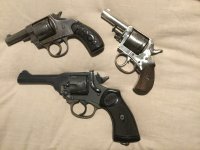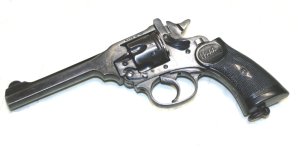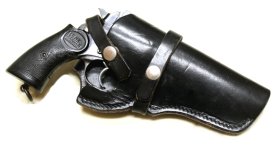Driftwood Johnson
New member
Howdy
As has been stated, there is no such thing as 38 S&W Short, although some folks call it that. Clearly, Fiocchi did not get the memo.

Here is a 38 S&W on the left and a 38 Special on the right. As has been stated, bullet diameter for 38 S&W is officially .360, but I have had success loading the cartridge with some .359 diameter bullets. Also, the case is slightly larger in diameter than 38 Special, so if chambers are in spec a 38 S&W cartridge should not chamber in a 38 Special revolver.

Smith and Wesson developed the 38 S&W cartridge in 1876 for their 38 Single Action, 1st Model, also known as the Baby Russian.

This 38 Double Action, chambered for 38 S&W, shipped in 1898.

These 38 Double Action Perfected models shipped between 1912 and 1917.

The I frame was slightly smaller than the K frame. When chambered for a 38, the cylinder was not large enough for six chambers. The five shot 38 Regulation Police at the top of this photo shipped in 1924. The six shot 32 Regulation Police below it shipped in 1925.

Yes, Smith and Wesson shipped over 500,000 K frame Victory models chambered for the 38 S&W cartridge to England between 1940 and 1945. These were made for a slightly more powerful version of the 38 S&W cartridge, using a 200 grain bullet. Many of these were rechambered for 38 Special when they returned to the US, but they are poor conversions because the rear of the chambers will have the larger diameter chambers for the 38 S&W cartridge while the lengthened part of the chambers will be slightly narrower for 38 Special brass. The wider section at the rear of the chambers often causes 38 Special brass to split.
As has been stated, there is no such thing as 38 S&W Short, although some folks call it that. Clearly, Fiocchi did not get the memo.
Here is a 38 S&W on the left and a 38 Special on the right. As has been stated, bullet diameter for 38 S&W is officially .360, but I have had success loading the cartridge with some .359 diameter bullets. Also, the case is slightly larger in diameter than 38 Special, so if chambers are in spec a 38 S&W cartridge should not chamber in a 38 Special revolver.
Smith and Wesson developed the 38 S&W cartridge in 1876 for their 38 Single Action, 1st Model, also known as the Baby Russian.
This 38 Double Action, chambered for 38 S&W, shipped in 1898.
These 38 Double Action Perfected models shipped between 1912 and 1917.
The I frame was slightly smaller than the K frame. When chambered for a 38, the cylinder was not large enough for six chambers. The five shot 38 Regulation Police at the top of this photo shipped in 1924. The six shot 32 Regulation Police below it shipped in 1925.
Yes, Smith and Wesson shipped over 500,000 K frame Victory models chambered for the 38 S&W cartridge to England between 1940 and 1945. These were made for a slightly more powerful version of the 38 S&W cartridge, using a 200 grain bullet. Many of these were rechambered for 38 Special when they returned to the US, but they are poor conversions because the rear of the chambers will have the larger diameter chambers for the 38 S&W cartridge while the lengthened part of the chambers will be slightly narrower for 38 Special brass. The wider section at the rear of the chambers often causes 38 Special brass to split.



